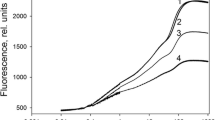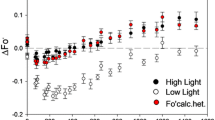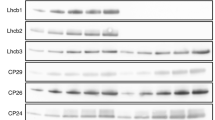Abstract
Arabidopsis plants were grown from seeds at different photon flux densities (PFDs) of white light ranging from 65 to 800 µmol photons m−2 s−1. Increasing PFD brought about a marked accumulation of plastoquinone (PQ) in leaves. However, the thylakoid photoactive PQ pool, estimated to about 700 pmol mg−1 leaf dry weight, was independent of PFD; PQ accumulation in high light mostly occurred in the photochemically non-active pool (plastoglobules, chloroplast envelopes) which represented up to 75% of total PQ. The amounts of PSII reaction center (on a leaf dry weight basis) also were little affected by PFD during growth, leading to a constant PQ/PSII ratio at all PFDs. Boosting PQ biosynthesis by overexpression of a solanesyl diphosphate-synthesizing enzyme strongly enhanced the PQ levels, particularly at high PFDs. Again, this accumulation occurred exclusively in the non-photoactive PQ pool. Mutational suppression of the plastoglobular ABC1K1 kinase led to a selective reduction of the thylakoid PQ pool size to ca. 400 pmol mg−1 in a large range of PFDs, which was associated with a restriction of the photosynthetic electron flow. Our results show that photosynthetic acclimation to light intensity does not involve modulation of the thylakoid PQ pool size or the amounts of PSII reaction centers. There appears to be a fixed amount of PQ molecules for optimal interaction with PSII and efficient photosynthesis, with the extra PQ molecules being stored outside the thylakoid membranes, implying a tight regulation of PQ distribution within the chloroplasts.








Similar content being viewed by others
References
Amesz J (1973) The function of plastoquinone in photosynthetic electron transport. Biochim Biophys Acta 301:35–51
Austin JR II, Frost E, Vidi PA, Kessler F, Staehelin LA (2006b) Plastoglobules are lipoprotein subcompartments of the chloroplast that are permanently coupled to thylakoid membranes and contain biosynthetic enzymes. Plant Cell 18:1693–1703
Bailey S, Walters RG, Jansson S, Horton P (2001) Acclimation of Arabidopsis thaliana to the light environment: the existence of separate low light and high light responses. Planta 213:794–801
Ballottari M, Dall’Osto L, Morosinotto T, Bassi R (2007) Contrasting behavior of higher plant photosystem I and II antenna systems during acclimation. J Biol Chem 282:8947–8958
Bielczynski LW, Schansker G, Croce R (2016) Effect of light acclimation on the organization of photosystem II super- and sub-complexes in Arabidopsis thaliana. Front Plant Sci 7:105
Boardman NK (1977) Comparative photosynthesis of sun and shade plants. Annu Rev Plant Physiol 28:355–377
Bréhélin C, Kessler F (2008) The plastoglobule: a bag full of lipid biochemistry tricks. Photochem Photobiol 84:1388–1394
Caffarri S, Kouril R, Kereïche S, Boekema EJ, Croce R (2009) Functional architecture of higher plant photosystem II supercomplexes. EMBO J 28:3052–3063
Carol P, Stevenson D, Bisanz C, Breitenbach J, Sandmann G, Mache R, Coupland G, Kuntz M (1999) Mutations in the Arabidopsis gene IMMUTANS cause a variegated phenotype by inactivating a chloroplast terminal oxidase associated with phytoene desaturation. Plant Cell 11:57–68
Crane FL (2010) Discovery of plastoquinone: a personal perspective. Photosynth Res 103:195–209
Crepin A, Kučerová Z, Kosta A, Durand E, Caffarri S (2020) Isolation and characterization of a large photosystem I–light-harvesting complex II supercomplex with an additional Lhca1–a4 dimer in Arabidopsis. Plant J 102:398–409
Dietz K-J (2015) Efficient high light acclimation involves rapid processes at multiple mechanistic levels. J Exp Bot 66:2401–2414
Espinoza-Corral R, Swentkert S, Lundquist PK (2021) Molecular changes of Arabidopsis thaliana plastoglobules facilitate thylakoid membrane remodeling under high light stress. Plant J 106:1571–1587
Eugeni Piller L, Besagni C, Ksas B, Rumeau D, Bréhelin C, Glauser G, Kessler F, Havaux M (2011) Chloroplast lipid droplet type II NAD(P)H quinone oxidoreductase is essential for prenylquinone metabolism and vitamin K1 accumulation. Proc Natl Acad Sci USA 108:14354–14359
Eugeni Piller L, Abraham M, Dörmann P, Kessler F, Besagni C (2012) Plastid lipid droplets at the crossroads of prenylquinone metabolism. J Exp Bot 63:1609–1618
Ferretti U, Ciura J, Ksas B, Rac M, Sedlarova M, Kruk J, Havaux M, Pospisil P (2018) Chemical quenching of singlet oxygen by plastoquinols and their oxidation products in Arabidopsis. Plant J 95:848–861
Flannery SE, Hepworth C, Wood WH, Pastoralli F, Hunter CN, Dickman MJ, Jackson PJ, Johnson MP (2021) Developmental acclimation of the thylakoid proteome to light intensity in Arabidopsis. Plant J 105:223–244
Forbush B, Kok K (1968) Reaction between primary and secondary electron acceptors of photosystem II of photosynthesis. Biochim Biophys Acta 162:243–253
Haldimann P, Tsimilli-Michael M (2005) Non-photochemical quenching of chlorophyll a fluorescence by oxidised plastoquinone: new evidences based on modulation of the redox state of the endogenous plastoquinone pool in broken spinach chloroplasts. Biochim Biophys Acta 1706:239–249
Havaux M (2020) Plastoquinone in and beyond photosynthesis. Trends Plant Sci 25:1252–1265
Johnson MP, Vasilev C, Olsen JD, Hunter CN (2014) Nanodomains of cytochrome b6f and photosystem II complexes in spinach grana thylakoid membranes. Plant Cell 26:3051–3061
Kirchhoff H, Horstmann S, Weis E (2000) Control of the photosynthetic electron transport by PQ diffusion microdomains in thylakoids of higher plants. Biochim Biophys Acta 1459:148–168
Kirchhoff H, Mukerjee U, Galla H-J (2002) Molecular architecture of the thylakoid membrane: lipid diffusion space for plastoquinone. Biochemistry 41:4872–4882
Ksas B, Becuwe N, Chevalier A, Havaux M (2015) Plant tolerance to excess light energy and photooxidative damage relies on plastoquinone biosynthesis. Sci Rep 5:10919
Ksas B, Legeret B, Ferretti U, Chevalier A, Pospisil P, Alric J, Havaux M (2018) The plastoquinone pool outside the thylakoid membrane serves in plant photoprotection as a reservoir of singlet oxygen scavengers. Plant Cell Environ 41:2277–2287
Laemmli UK (1970) Cleavage of structural proteins during the assembly of the head of bacteriophage T4. Nature 227:680–685
Lichtenthaler HK (2007) Biosynthesis, accumulation and emission of carotenoid, alph-tocopherol, plastoquinone and isoprenein leaves under high photosynthetic irradiance. Photosynth Res 92:163–179
Lichtenthaler HK, Wellburn AR (1983) Determinations of total carotenoids and chlorophylls a and b of leaf extracts in different solvents. Biochem Soc Trans 11:591–592
Lundquist PK, Poliakov A, Giacomelli L, Friso G, Appel M, McQuinn RP, Krasnoff SB, Rowland E, Ponnala L, Sun Q, van Wijk KJ (2013) Loss of plastoglobule kinases ABC1K1 and ABC1K3 causes conditional degreening, modified prenyl-lipids, and recruitment of the jasmonic acid pathway. Plant Cell 25:1818–1839
Martinis J, Glauser G, Valimareanu S, Stettler M, Zeeman SC, Yamamoto H, Shikanai T, Kessler F (2014) ABC1K1/PGR6 kinase: a regulatory link between photosynthetic activity and chloroplast metabolism. Plant J 77:269–283
Mathur S, Jain L, Jajoo A (2018) Photosynthetic efficiency in sun and shade plants. Photosynthetica 56:354–365
McCauley SW, Melis A (1986) Quantification of plastoquinone photoreduction in spinach chloroplasts. Photosynth Res 8:3–16
Nowicka B, Kruk J (2010) Occurrence, biosynthesis and function of isoprenoid quinones. Biochim Biophys Acta 1797:1587–1605
Nowicka B, Trela-Makowej A, Latowski D, Strzalka K, Szymanska R (2021) Antioxidant and signaling role of plastid-derived isoprenoid quinones and chromanols. Int J Mol Sci 22:2950
Pralon T, Shanmugabalaji V, Longoni P, Glauser G, Ksas B, Collombat J, Desmeules S, Havaux M, Finazzi G, Kessler F (2019) Plastoquinone homoeostasis by Arabidopsis proton gradient regulation 6 is essential for photosynthetic efficiency. Commun Biol 2:220
Pralon T, Collombat J, Pipitone R, Ksas B, Shanmugabalaji V, Havaux M, Finazzi G, Longoni P, Kessler F (2020) Mutation of the atypical kinase ABC1K3 partially rescues the proton gradient regulation 6 phenotype in Arabidopsis thaliana. Front Plant Sci 11:337
Pshybytko NL, Kruk J, Kabashnikova LF, Strzalka K (2008) Function of plastoquinone in heat stress reactions of plants. Biochim Biophys Acta 1777:1393–1399
Rochaix J-D (2011) Regulation of photosynthetic electron transport. Biochim Biophys Acta 1807:375–383
Stiehl HD, Witt H (1969) Quantitative treatment of the function of plastoquinone in photosynthesis. Z Naturforsch B 24:1588–1598
Suslichenko IS, Tikhonov AN (2019) Photo-reducible plastoquinone pools in chloroplasts of Tradescentia plants acclimated to high and low light. FEBS Lett 593:788–798
Szymanska R, Kruk J (2010) Plastoquinol is the main prenyllipid synthesized during acclimation to high light conditions in Arabidopsis and is converted to plastochromanol by tocopherol cyclase. Plant Cell Physiol 51:537–545
Van Wijk KJ, Kessler F (2017) Plastoglobuli: plastid microcompartments with integrated functions in metabolism, plastid developmental transitions, and environmental adaptation. Annu Rev Plant Biol 68:253–289
Vidi PA, Kanwischer M, Baginsky S, Austin JR, Csucs G, Dörmann P, Kessler F, Bréhélin C (2006) Tocopherol cyclase (VTE1) localization and vitamin E accumulation in chloroplast plastoglobule lipoprotein particles. J Biol Chem 281:11225–11234
Wientjes E, Philippi J, Borst JW, van Amerongen H (2017) Imaging the photosystemI/photosystem II chlorophyll ratio inside the leaf. Biochim Biophys Acta 1858:259–265
Wu D, Wright DA, Wetzel C, Voytas DF, Rodermel S (1999) The IMMUTANS variegation locus of Arabidopsis defines a mitochondrial alternative oxidase homolog that functions during early chloroplast biogenesis. Plant Cell 11:43–55
Yadav DK, Kruk J, Sinha RK, Pospíšil P (2010) Singlet oxygen scavenging activity of plastoquinol in photosystem II of higher plants: electron paramagnetic resonance spin-trapping study. Biochim Biophys Acta 1797:1807–1811
Zbierzak AM, Kanwischer M, Wille C, Vidi PA, Giavalisco P, Lohmann A, Briesen I, Porfirova S, Bréhélin C, Kessler F, Dörmann P (2009) Intersection of the tocopherol and plastoquinol metabolic pathways at the plastoglobule. Biochem J 425:389–399
Zechmann B (2019) Ultrastructure of plastids serves as reliable abiotic and biotic stress marker. PLoS ONE 14(4):e0214811
Acknowledgements
We thank the members of the Phytotec platform (CEA Cadarache) for their help in growing Arabidopsis plants at different PFDs. Seeds of the abc1k1 mutant were received from Felix Kessler (University of Neuchâtel, Switzerland).
Funding
Financial support from CEA (Radiobiology 2019 program), CNRS (Metaphores 2020–2021 project) and ECCOREV is acknowledged.
Author information
Authors and Affiliations
Contributions
MH conceived the project and designed the experiments. BK performed most experiments. JA performed biophysical analyses of PSII content. SC performed biochemical analyses of the photosynthetic complexes. MH wrote the article with input from all the other authors.
Corresponding author
Ethics declarations
Conflict of interest
The authors declare that they have no conflict of interest.
Additional information
Publisher's Note
Springer Nature remains neutral with regard to jurisdictional claims in published maps and institutional affiliations.
Supplementary Information
Below is the link to the electronic supplementary material.
Rights and permissions
About this article
Cite this article
Ksas, B., Alric, J., Caffarri, S. et al. Plastoquinone homeostasis in plant acclimation to light intensity. Photosynth Res 152, 43–54 (2022). https://doi.org/10.1007/s11120-021-00889-1
Received:
Accepted:
Published:
Issue Date:
DOI: https://doi.org/10.1007/s11120-021-00889-1




